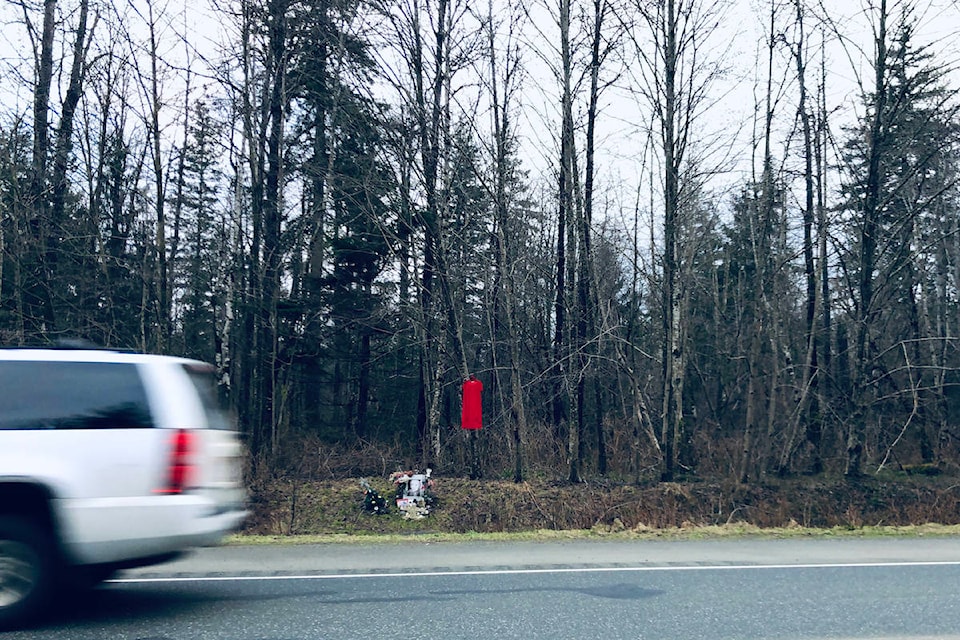On Sunday, five women from Gold River hung a red dress by the side of the road that leads into town.
Supporting their cause was Evangeline James a member of the area’s Mowachaht/Muchalaht First Nation (MMFN).
In 1979, James’ friend, 26-year-old Christine Thomas was murdered between Campbell River and Gold River on Highway 28 in 1979, along with her 16-year-old sister Helena Howard.
For James, the red dress is a great way to honour the sisters while also expressing solidarity to the cause of Murdered and Missing Indigenous Women and Girls (MMIWG).
“In our community it’s something that we have acknowledged to have had young women go missing, but things such as the red dress project was never something that took off here,” said another MMFN member, Barb Wilson, who has a red dress in her patio in memory of her friend Norma (also missing from Gold River).
RELATED: RCMP needs structural changes to address racism: MMIWG commissioner
RELATED: B.C. woman’s ‘Red Dress’ for missing, murdered Indigenous woman interrupts mail delivery
Terra Mather spearheaded the Gold River effort after coming across the efforts of Campbell River’s Stephanie Elickus-Rivers, who is in the process of hanging more than 100 dresses along the highway from Port Hardy to Victoria.
The Red Dress Project took off in 2010 after Métis artist Jamie Black put up installations of red dresses in Manitoba to represent Indigenous women/girls lost to violent crimes. Over the years, the project evolved into a powerful awareness tool and a conversation starter about missing or murdered Aboriginal women in most communities across the country.
Mather connected with her Gold River community members on social media and they decided to hang a red dress up in their community too.
Seeing a red dress is a sombre feeling for many, some find it creepy and there are yet some who do not know what it is, said Elickus-Rivers, which is why the awareness drive continues.
According to Elickus-Rivers, who lost her niece and best friend to violent deaths, red dresses hung up in communities is also a way of sending a message to predators who “prey on vulnerable women.”
“They will know that people are watching and looking for these women, and men and children in their communities,” she said.
Elickus-Rivers also intends to compile data and videos to submit to the government as she feels there is a huge gap in the statistics and data of MMIWG from Vancouver Island and B.C. in general.
The data is “murky” because a lot of cases were never reported and many of the reported missing cases are not taken seriously, especially if they’re associated with people with addictions, said Elickus-Rivers.
In 2019 the report by the National Inquiry into Missing and Murdered Indigenous Women and Girls stated that there was no “reliable estimate of the numbers of missing and murdered Indigenous women, girls, and 2SLGBTQQIA persons in Canada,” partly because Canada did not maintain a database for missing people until 2010.
The estimates for Vancouver Island may be far more than reported, according to Marcia Turner, an Indigenous relations expert who organized the 2016 provincial gathering for the families of MMIWG on behalf of Indigenous leaders and the BC Government.
Based on the number of Island families that participated in the provincial gathering, Turner gathered that it was significantly higher than the numbers associated with the Highway of Tears.
“How we understand MMIWG in this province, in this country, looks different, and the circumstances are very different. But there’s a common theme,that we’ve echoed consistently – its linkage to the impact of colonization. That broader policy piece has to be addressed in order for change to happen,” said Turner.
In addition to hanging dresses, North Island groups are also organizing an annual edition of the Women’s Memorial March – an event that originated in Vancouver 28 years ago. The march began as a commitment to end violence that Indigenous women in Canada face on a daily basis.
On Feb. 14 in Campbell River, members from various organizations will come together for the Campbell River Stolen Sisters Memorial March to be held downtown.
For more news from Vancouver Island and beyond delivered daily into your inbox, please click here.
